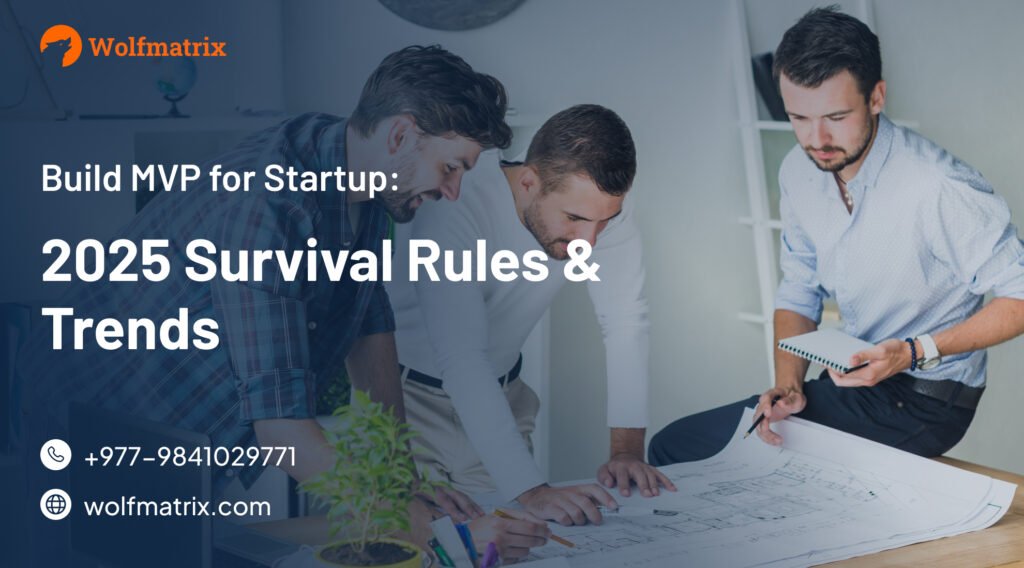The startup apocalypse is real. 90% of startups fail within 10 years, but here’s what the survivors know that the casualties don’t: the rules for how to build MVP for startup success have completely changed in 2025.
While 21% of new businesses fail within their first year, and more than half close their doors by the five-year mark, there’s a hidden pattern among the 10% that survive. They’ve cracked the code on 2025’s new MVP development survival rules—rules that make the difference between joining the graveyard of failed ventures or building the next billion-dollar company.
The old MVP playbook is dead. The new survival framework isn’t just about building faster or cheaper—it’s about building smarter in an ecosystem where tech startups face a 60% failure rate and traditional approaches guarantee obsolescence.
Why 2025 Changed Everything: The Great MVP Evolution
The Survival Statistics that Keep Founders Awake
With nearly 90% of startups failing, the stakes have never been higher. But here’s the breakthrough insight: startups adopting rapid MVP strategies achieve 67% higher funding success rates and 2.3x faster market entry.
The difference isn’t luck—it’s methodology. The companies surviving 2025’s brutal competitive landscape have mastered new rules that separate the funded from the forgotten.
Technology remains the leading sector for new ventures, with 1 in 5 startups being tech-focused. Yet tech startup failure rates have exceeded 60%, creating a lesson in what not to do.
The survivors? They’ve learned that when you build MVP for startup validation in 2025, you’re not just creating a product—you’re building a data-driven survival system.
The 2025 MVP Development Survival Rules: What Winners Know
Rule 1: The 90-Day Validation Imperative
The new survival timeline is ruthless: 90 days from idea to validated MVP. This isn’t about rushing, it’s about rapid market conversation. 74% of fast-growing internet companies fail because they scaled too quickly without proper market validation through an MVP.
The 90-Day Framework:
- Days 1-30: Market validation and problem-solution fit
- Days 31-60: Prototype app service development and testing
- Days 61-90: Launch, measure, and iterate based on real user data
Rule 2: Industry-Specific Survival Rates Demand Tailored Strategies
Healthcare startups have a 15% higher five-year survival rate compared to the average across all industries, proving that industry choice and approach matter more than ever.
2025 Industry Survival Intelligence:
- Fintech: 242 unicorns in the US alone, but high regulatory complexity demands MVP compliance planning
- Healthcare: Higher survival rates due to real problem-solving focus and regulatory protection
- Gaming: Highest MVP success rates due to rapid user feedback loops and clear engagement metrics
Rule 3: The AI-Powered MVP Advantage
Artificial intelligence isn’t just a feature in 2025, it’s a survival tool. Companies using AI in their MVP development process report 60% faster iteration cycles and deeper user insight generation.
AI Integration Points for 2025 MVPs:
- Automated user behavior analysis
- Predictive feature prioritization
- Real-time market sentiment tracking
- Intelligent A/B testing optimization
How Billion-Dollar Companies Mastered MVP Development Rules
Netflix: The $240 Billion DVD Gamble
Netflix‘s original MVP wasn’t streaming, it was DVD-by-mail. Their founders tested market demand for convenient movie rentals before building the technology infrastructure that would eventually disrupt entire industries.
The 2025 Lesson: Start with service MVP validation before building technology solutions. Netflix proved demand for convenience before investing in streaming technology.
Uber: The $93 Billion Black Car Experiment
Uber‘s MVP focused solely on black cars in San Francisco. No rating systems, no surge pricing, no driver onboarding complexity, just a simple app connecting users to existing black car services.
The Survival Strategy: When you build MVP for startup success, focus on one city, one user type, one core need. Uber’s geographic and demographic focus provided clear validation before expansion.
Spotify: The Music Industry’s $26 Billion Disruption
Spotify’s MVP wasn’t about music discovery or social features, it was about instant music streaming without piracy guilt. They solved one massive user pain point before adding complexity.
The Market Validation Victory: Spotify proved users would pay for legal, instant music access before building playlist features, social integration, or recommendation algorithms.
The 2025 MVP Development Technology Revolution
Cloud-Native MVP Architecture: The New Standard
Traditional MVP development focused on quick and dirty solutions. 2025 survivors build cloud-native MVPs that scale effortlessly.
- Microservices Foundation: Build modular components that can scale independently
- Architecture rebuilds Serverless Components: Reduce operational overhead while maintaining performance
Security-First MVP Development
With cyber threats increasing 40% year-over-year, security isn’t optional, it’s survival. 2025 MVPs integrate security from day one:
- Authentication Systems: Multi-factor authentication and secure session management
- Data Encryption: End-to-end encryption for all user data transmission
- API Security: Rate limiting, input validation, and secure endpoints
- Compliance Planning: GDPR, CCPA, and industry-specific regulation compliance
- MVP Development Services: The Partnership Revolution
The Rise of specialized MVP Agencies
MVP development services have evolved from basic coding shops to strategic business partners. Leading mvp agency firms now offer:
- Business Strategy Integration: Market analysis and competitive positioning guidance
- Technical Architecture Planning: Scalable foundation design for future growth
- User Experience Optimization: Conversion-focused design that maximizes validation data
- Post-Launch Growth Support: Iteration planning and scaling technical assistance
MVP Pricing Evolution: Investment vs. Cost
Building an MVP in 2025 costs anywhere from $5,000 to $150,000, but smart founders evaluate cost to build mvp against risk mitigation value:
Lean MVP Investment: $15,000 – $35,000
- Core functionality validation
- Single platform focus
- Basic analytics integration
- Standard security implementation
Growth-Ready MVP Investment: $35,000 – $80,000
- Multi-platform compatibility
- Advanced user analytics
- AI integration points
- Scalable architecture planning
Enterprise MVP Investment: $80,000 – $150,000
- Complex integration requirements
- Advanced security protocols
- Real-time feature capabilities
- Custom backend architecture
Click-Through Prototype: The Pre-MVP Validation Tool
Click-through prototype development has become essential for 2025 MVP success. These interactive mockups provide:
- User Experience Validation: Test navigation and feature flow before development
- Stakeholder Alignment: Visualize concepts for investors and team members
- Development Risk Reduction: Identify usability issues before coding begins
- Budget Optimization: Prevent costly changes during development phases
Common 2025 MVP Development Pitfalls (And How to Avoid Them)
The Feature Creep Death Spiral
Even with new survival rules, founders still fall into feature complexity traps. Instagram’s success came from stripping away Burbn’s multiple features to focus solely on photo-sharing.
The Focus Formula:
- Identify your ONE core value proposition
- Remove every feature that doesn’t directly support that value
- Save additional features for post-validation iterations
The Validation Confirmation Bias
Entrepreneurs naturally seek feedback that confirms their assumptions. Combat this through:
Diverse User Testing: Include users outside your network and demographic Behavioral Data Over Opinions: Measure what users do, not what they say Negative Feedback Analysis: Actively seek and analyze criticism Competitor User Research: Study why users choose alternative solutions
The Technical Debt Time Bomb
Rapid MVP development can create technical shortcuts that explode during scaling. Prevent this through:
- Architecture Planning: Design for 10x growth from day one
- Code Quality Standards: Maintain documentation and testing protocols
- Performance Monitoring: Track response times and system reliability
- Security Auditing: Regular security assessments and vulnerability testing
Market Validation Strategies that actually work in 2025
Idea Validation Through Digital Channels
Modern idea validation leverages digital tools for rapid market testing:
- Landing Page Experiments: Test demand through pre-launch signup campaigns
- Social Media Validation: Build audiences around problem discussions
- Search Volume Analysis: Validate problem awareness through keyword research
- Competitor Analysis: Study successful solutions in adjacent markets
Real-World Validation Techniques
Digital validation must be paired with real-world testing:
- Customer Interview Programs: Systematic feedback collection from target users
- Beta Testing Communities: Engaged user groups providing detailed feedback
- Partner Validation: Industry connections confirming market demand
- Pre-Sale Campaigns: Revenue generation before product completion
The Future of MVP Development: Trends Shaping 2025 and Beyond
No-Code/Low-Code Revolution
No-code platforms are democratizing MVP creation, enabling non-technical founders to build MVP for startup validation independently. However, technical scalability planning remains crucial for post-validation growth.
Sustainable Development Practices
Environmental consciousness influences MVP development approaches:
- Energy-efficient coding practices reducing operational costs
- Sustainable hosting solutions for long-term viability
- Green technology integrations appealing to conscious consumers
Remote-First Development Teams
Global talent access enables startups to build world-class MVPs regardless of geographic location, but requires new management and communication protocols.
Why Wolfmatrix Understands 2025’s MVP Survival Rules?
At Wolfmatrix, we’ve witnessed the transformation from traditional development to survival-focused MVP creation. Our experience scaling Australian logistics and healthcare companies from failed systems to market-ready solutions proves that 2025’s new rules aren’t theoretical—they’re practical frameworks for sustainable growth.
We combine rapid development capabilities with strategic business insight, ensuring your MVP validates market demand while establishing technical foundations that support, rather than limit, future growth.
Our approach recognizes that when you build MVP for startup success in 2025, you’re not just creating software—you’re building a data-driven foundation for every future business decision.
The Survival Decision: Adapt or Become a Statistic
The 2025 startup landscape is unforgiving. Only 10% of startups survive beyond 10 years, and those odds haven’t improved with traditional approaches. But companies mastering 2025’s new MVP development survival rules are rewriting those statistics.
Every day spent building assumptions instead of validated solutions is another day competitors might be gathering real user feedback, iterating based on market data, and building sustainable competitive advantages.
Your MVP isn’t just your first product—it’s your first real market conversation. In 2025, that conversation determines whether you join the 90% that fail or the 10% that thrive.
The Choice Is Binary: Master 2025’s new survival rules or become another cautionary statistic. Choose data-driven development over assumption-based building. Choose validated learning over speculative investment. Choose to build MVP for startup success using frameworks that actually work in today’s competitive landscape.
The survivors of 2025’s startup apocalypse aren’t the lucky ones—they’re the ones who learned the new rules before their competitors did.
Ready to join the 10% that survive? Your MVP journey begins with understanding that in 2025, perfect is still the enemy of shipped, but unvalidated is the enemy of everything. Contact us today and start building smarter, faster, and stronger.




